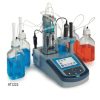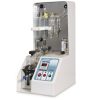TITRALAB AT1000 HACH LANGE:
Reliable results and easy setup.

Sulfur dioxide is effective against both bacteria and yeasts: its antiseptic power depends fundamentally on the concentration in its molecular form.
During fermentation, some yeasts and many bacteria are more sensitive than others to the effects of SO2, so an important selection process takes place.
In the right concentration, SO2 in musts and wines prevents the growth of unwanted yeasts and bacteria such as Brettanomyces, Pediococci and Lactobacilli acetic bacteria and keeps selected ones such as Saccharomyces active.
The enzyme, produced by Botrytis cinerea present in moldy grapes, is less sensitive to sulphites.
To neutralize yeasts in wine, small quantities of molecular SO2 are sufficient because another powerful antiseptic comes into play: alcohol.
In refining, its antiseptic activity depends on the concentration in the molecular form and Bisulphite Ion therefore on the pH, temperature and alcohol.
During storage, SO2 inhibits all microorganisms, thus avoiding unwanted refermentations or revitalization of yeasts in the bottle. Continue reading →
Enzymatic oxidation of SO2 in oenology
So2 in Oenology
Enzymatic oxidation Polyphenol oxidase
 Among the active enzymes of grapes, during fermentation we have positive ones (e.g. β-glucosidase and esterase) and negative ones, such as the oxidase enzyme (polyphenol oxidase).
Among the active enzymes of grapes, during fermentation we have positive ones (e.g. β-glucosidase and esterase) and negative ones, such as the oxidase enzyme (polyphenol oxidase).
Enzymatic oxidation or polyphenol oxidase (PPO) by grape enzymes (tyrosinase) or molds (Botrytis cinerea and Laccase), transforms phenolic compounds (flavan-3-ols, caffeine-oil-tartaric acid, etc.) into quinones, causing enzymatic browning.
In healthy grapes, tyrosinase is the main enzyme involved in browning reactions.
Sulfur dioxide works by reducing the activity of the degenerative enzyme tyrosinase (polyphenol oxidase) present in the must (browning).
It can also be eliminated with clarification or hyper-oxygenation
Laccase, on the other hand, produced by Botrytis cinerea, is not very sensitive to either bentonite treatments or sulphite additions, and therefore constitutes a big problem for producers.
During winemaking, PPO activity decreases in relation to the formation of alcohol, the decrease in pH and the precipitation of proteins.
These phenolic reactions, both enzymatic and non-enzymatic, result in the formation of secondary products called quinones which are directly involved in all oxidation processes.
SO2 and O2 Oxidation and Protection Processes
So2 in Oenology
Oxidation is the term used by chemists to describe when an element or compound loses electrons; oxygen is often involved in this process because it readily accepts one or more electrons when it reacts with an element or compound.
We have seen that oxidation during grape harvesting is of an enzymatic type while in subsequent processes it is of a non-enzymatic or chemical type.
SO2 acts as an inhibitor on the chemical oxidations of phenolic substances which, if not properly protected, oxidize, compromising the colouring substances, tannins, aromatic substances and therefore the organoleptic quality of the wine.
The risk increases with the presence of powerful reaction catalysts such as metal ions of copper and iron.
So2 is used in viticulture to prevent these oxidations but it does not act directly by eliminating oxygen from wines and musts: although the sulfite ion (So3 2 – ) can bind to oxygen, there is practically no sulfite ion in solution in the pH range found in wine.
To fully understand the interactions between polyphenols and O2, it is necessary to study the chemical reactions that occur during this process.

 Continue reading →
Continue reading →
We have seen that oxidation during grape harvesting is of an enzymatic type while in subsequent processes it is of a non-enzymatic or chemical type.
SO2 acts as an inhibitor on the chemical oxidations of phenolic substances which, if not properly protected, oxidize, compromising the colouring substances, tannins, aromatic substances and therefore the organoleptic quality of the wine.
The risk increases with the presence of powerful reaction catalysts such as metal ions of copper and iron.
So2 is used in viticulture to prevent these oxidations but it does not act directly by eliminating oxygen from wines and musts: although the sulfite ion (So3 2 – ) can bind to oxygen, there is practically no sulfite ion in solution in the pH range found in wine.
To fully understand the interactions between polyphenols and O2, it is necessary to study the chemical reactions that occur during this process.

 Continue reading →
Continue reading →Acetaldehyde
So2 in Oenology
During alcoholic fermentation acetaldehyde is produced:
- from yeast in the metabolism of sugars starting from pyruvate in the formation of ethanol
- subsequently it is the product of the oxidation of ethanol itself through oxidation processes of polyphenols, oxygen activated by the peroxide in Fe+
In red wines, acetic acid is in lower concentrations because it reacts with anthocyanins and tannins to create stable polymer pigments; it is also partially “consumed” by lactic acid bacteria during malolactic fermentation.
Knowing its exact concentration is extremely important because it combines with SO2, limiting its antioxidant and antiseptic power.

One of the most important aspects is its ability to bind to acetic aldehyde
It is a strong bond but reversible in fact in some oxidations Acetaldehyde is released
The proportion is 1 mg/L of acetaldehyde combines with 1.45 mg/L of So2.
It is necessary to use the right quantities of So2 because in the presence of excessive doses the yeasts react by producing more acetaldehyde, which will tend to combine and therefore make the treatment ineffective.
In unprotected wines, in contact with oxygen the bacteria produce acetaldehyde which represents the intermediate stage of acetic acid.

So2 in Oenology
Sulfur dioxide gas gives off a pungent, acrid aroma reminiscent of a burnt match.
It is not possible to make wine without SO2 because all yeasts during fermentation produce sulphites as a metabolic intermediate in the reduction of sulphates.
Yeast strains can be classified into low SO2 producers (e.g. Saccharomyces cerevisiae var. ellipsoideus) and high producers (e.g. Saccharomyces bayanus Sacardo).
The consumer is increasingly sensitive to the issues of sustainability and green production; a trend recorded by a strong growth in the consumption of “Bio” products.
Numerous alternatives to the use of sulfur dioxide in musts and wines are currently being studied; however, it remains the most representative preservative for the wine sector.
Sulphur dioxide has several properties of oenological interest:
- It is an antimicrobial: it helps prevent the development of bacterial microbes and inhibits unselected yeasts
- It is an antioxidant due to its ability to inhibit enzymatic browning
- It is an antioxidant due to its ability to reduce chemical oxidations of phenolic substances.
- helps prevent aromas and color during storage to preserve the qualities and characteristics of the wine.
- promotes turbidity by facilitating the separation of suspended fecal substances.
It is used during all stages of production, from harvest to refinement.
It is important to calculate the right dose at the right time, to carry out the desired task without excess and without compromising the quality of the wine
Density Analysis of Vinegar with ALM-155
ALM-155 is a high-precision oscillating capillary densimeter within everyone’s reach, suitable for analyzing the density of wine or balsamic vinegars, glazes, wines and musts. After distilling the sample, it is also possible to measure the alcohol content.
Main features:
- Density analysis (volume mass), density 20/20 and alcohol content according to the official method.
- Centesimal resolution for alcohol (OIV compliant)
- Resolution to the fifth decimal place for relative density (20/20) and density
- Peltier thermostat fixed at 20.00°C +/-0.03°C (OIV compliant)
- One or two calibration points of your choice (water only or water and air, OIV compliant)
- Standard equipment with peristaltic pump for sample aspiration and washing at the end of the analysis.
- Self-installing and very easy to use, it requires no maintenance other than washing the cell at the end of the work.
- Direct expression of the density value also in Brix, Babo and Baumè.









